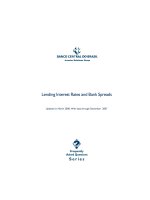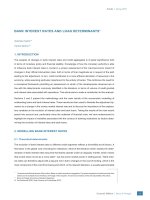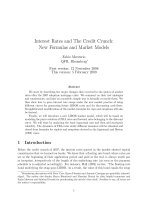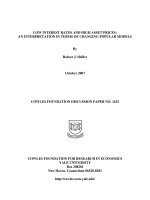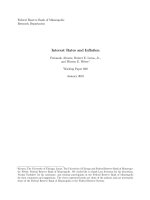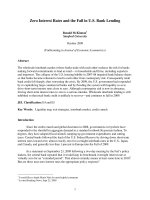Chapter 7 interest rates and bond valuation
Bạn đang xem bản rút gọn của tài liệu. Xem và tải ngay bản đầy đủ của tài liệu tại đây (577.4 KB, 47 trang )
Chapter 7
Interest Rates
and Bond
Valuation
McGraw-Hill/Irwin
Copyright © 2010 by The McGraw-Hill Companies, Inc. All rights reserved.
Key Concepts and Skills
•
Know the important bond features and bond
types
•
Understand bond values and why they
fluctuate
•
Understand bond ratings and what they mean
•
Understand the impact of inflation on interest
rates
•
Understand the term structure of interest rates
and the determinants of bond yields
7-2
Chapter Outline
•
Bonds and Bond Valuation
•
More about Bond Features
•
Bond Ratings
•
Some Different Types of Bonds
•
Bond Markets
•
Inflation and Interest Rates
•
Determinants of Bond Yields
7-3
Bond Definitions
•
Bond
•
Par value (face value)
•
Coupon rate
•
Coupon payment
•
Maturity date
•
Yield or Yield to maturity
7-4
Present Value of Cash Flows as
Rates Change
•
Bond Value = PV of coupons + PV of par
•
Bond Value = PV of annuity + PV of lump
sum
•
As interest rates increase, present values
decrease
•
So, as interest rates increase, bond prices
decrease and vice versa
7-5
Valuing a Discount Bond with
Annual Coupons
•
Consider a bond with a coupon rate of 10% and
annual coupons. The par value is $1,000, and the
bond has 5 years to maturity. The yield to maturity
is 11%. What is the value of the bond?
–
Using the formula:
•
B = PV of annuity + PV of lump sum
•
B = 100[1 – 1/(1.11)
5
] / .11 + 1,000 / (1.11)
5
•
B = 369.59 + 593.45 = 963.04
–
Using the calculator:
•
N = 5; I/Y = 11; PMT = 100; FV = 1,000
•
CPT PV = -963.04
7-6
Valuing a Premium Bond with
Annual Coupons
•
Suppose you are reviewing a bond that has a 10%
annual coupon and a face value of $1000. There
are 20 years to maturity, and the yield to maturity
is 8%. What is the price of this bond?
–
Using the formula:
•
B = PV of annuity + PV of lump sum
•
B = 100[1 – 1/(1.08)
20
] / .08 + 1000 / (1.08)
20
•
B = 981.81 + 214.55 = 1196.36
–
Using the calculator:
•
N = 20; I/Y = 8; PMT = 100; FV = 1000
•
CPT PV = -1,196.36
7-7
Graphical Relationship Between
Price and Yield-to-maturity (YTM)
Bond Price
Yield-to-maturity (YTM)
7-8
Bond Prices: Relationship
Between Coupon and Yield
•
If YTM = coupon rate, then par value = bond price
•
If YTM > coupon rate, then par value > bond price
–
Why? The discount provides yield above coupon rate
–
Price below par value, called a discount bond
•
If YTM < coupon rate, then par value < bond price
–
Why? Higher coupon rate causes value above par
–
Price above par value, called a premium bond
7-9
The Bond Pricing Equation
t
t
r)(1
FV
r
r)(1
1
-1
C Value Bond
+
+
+
=
7-10
Example 7.1
•
Find present values based on the payment
period
–
How many coupon payments are there?
–
What is the semiannual coupon payment?
–
What is the semiannual yield?
–
B = 70[1 – 1/(1.08)
14
] / .08 + 1,000 / (1.08)
14
=
917.56
–
Or PMT = 70; N = 14; I/Y = 8; FV = 1,000; CPT
PV = -917.56
7-11
Interest Rate Risk
•
Price Risk
–
Change in price due to changes in interest rates
–
Long-term bonds have more price risk than short-term
bonds
–
Low coupon rate bonds have more price risk than high
coupon rate bonds
•
Reinvestment Rate Risk
–
Uncertainty concerning rates at which cash flows can
be reinvested
–
Short-term bonds have more reinvestment rate risk
than long-term bonds
–
High coupon rate bonds have more reinvestment rate
risk than low coupon rate bonds
7-12
Figure 7.2
7-13
Computing Yield to Maturity
•
Yield to Maturity (YTM) is the rate implied
by the current bond price
•
Finding the YTM requires trial and error if
you do not have a financial calculator and
is similar to the process for finding r with
an annuity
•
If you have a financial calculator, enter N,
PV, PMT, and FV, remembering the sign
convention (PMT and FV need to have the
same sign, PV the opposite sign)
7-14
YTM with Annual Coupons
•
Consider a bond with a 10% annual
coupon rate, 15 years to maturity and a
par value of $1,000. The current price is
$928.09.
–
Will the yield be more or less than 10%?
–
N = 15; PV = -928.09; FV = 1,000; PMT = 100
–
CPT I/Y = 11%
7-15
YTM with Semiannual
Coupons
•
Suppose a bond with a 10% coupon rate
and semiannual coupons, has a face value
of $1,000, 20 years to maturity and is
selling for $1,197.93.
–
Is the YTM more or less than 10%?
–
What is the semiannual coupon payment?
–
How many periods are there?
–
N = 40; PV = -1,197.93; PMT = 50; FV =
1,000; CPT I/Y = 4% (Is this the YTM?)
–
YTM = 4%*2 = 8%
7-16
Table 7.1
7-17
Current Yield vs. Yield to
Maturity
•
Current Yield = annual coupon / price
•
Yield to maturity = current yield + capital gains
yield
•
Example: 10% coupon bond, with semiannual
coupons, face value of 1,000, 20 years to
maturity, $1,197.93 price
–
Current yield = 100 / 1,197.93 = .0835 = 8.35%
–
Price in one year, assuming no change in YTM =
1,193.68
–
Capital gain yield = (1,193.68 – 1,197.93) / 1,197.93 =
0035 = 35%
–
YTM = 8.35 - .35 = 8%, which is the same YTM
computed earlier
7-18
Bond Pricing Theorems
•
Bonds of similar risk (and maturity) will be
priced to yield about the same return,
regardless of the coupon rate
•
If you know the price of one bond, you can
estimate its YTM and use that to find the
price of the second bond
•
This is a useful concept that can be
transferred to valuing assets other than
bonds
7-19
Bond Prices with a
Spreadsheet
•
There is a specific formula for finding
bond prices on a spreadsheet
–
PRICE(Settlement,Maturity,Rate,Yld,Redemption,
Frequency,Basis)
–
YIELD(Settlement,Maturity,Rate,Pr,Redemption,
Frequency,Basis)
–
Settlement and maturity need to be actual dates
–
The redemption and Pr need to be input as % of par
value
•
Click on the Excel icon for an example
7-20
Differences Between
Debt and Equity
•
Debt
–
Not an ownership interest
–
Creditors do not have
voting rights
–
Interest is considered a
cost of doing business and
is tax deductible
–
Creditors have legal
recourse if interest or
principal payments are
missed
–
Excess debt can lead to
financial distress and
bankruptcy
•
Equity
–
Ownership interest
–
Common stockholders
vote for the board of
directors and other issues
–
Dividends are not
considered a cost of doing
business and are not tax
deductible
–
Dividends are not a liability
of the firm, and
stockholders have no legal
recourse if dividends are
not paid
–
An all equity firm can not
go bankrupt merely due to
debt since it has no debt
7-21
The Bond Indenture
•
Contract between the company and the
bondholders that includes
–
The basic terms of the bonds
–
The total amount of bonds issued
–
A description of property used as security, if applicable
–
Sinking fund provisions
–
Call provisions
–
Details of protective covenants
7-22
Bond Classifications
•
Registered vs. Bearer Forms
•
Security
–
Collateral – secured by financial securities
–
Mortgage – secured by real property, normally
land or buildings
–
Debentures – unsecured
–
Notes – unsecured debt with original maturity
less than 10 years
•
Seniority
7-23
Bond Characteristics and
Required Returns
•
The coupon rate depends on the risk
characteristics of the bond when issued
•
Which bonds will have the higher coupon,
all else equal?
–
Secured debt versus a debenture
–
Subordinated debenture versus senior debt
–
A bond with a sinking fund versus one without
–
A callable bond versus a non-callable bond
7-24
Bond Ratings – Investment
Quality
•
High Grade
–
Moody’s Aaa and S&P AAA – capacity to pay is
extremely strong
–
Moody’s Aa and S&P AA – capacity to pay is very
strong
•
Medium Grade
–
Moody’s A and S&P A – capacity to pay is strong,
but more susceptible to changes in circumstances
–
Moody’s Baa and S&P BBB – capacity to pay is
adequate, adverse conditions will have more
impact on the firm’s ability to pay
7-25




